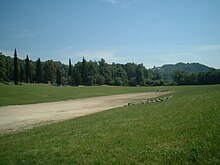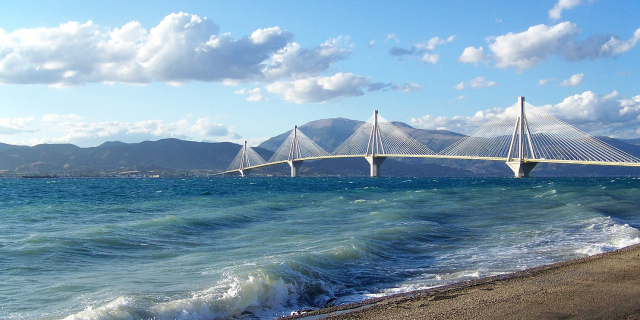Olympia (Modern Greek: Ολυμπία [oli(m)ˈbi.a]; Ancient Greek: Ὀλυμπία [olympí.aː]), officially Archaia Olympia (Modern Greek: Αρχαία Ολυμπία; Ancient Greek: Ἀρχαία Ὀλυμπία; "Ancient Olympia"), is a small town in Elis on the Peloponnese peninsula in Greece, famous for the nearby archaeological site of the same name. This site was a major Panhellenic religious sanctuary of ancient Greece, where the ancient Olympic Games were held every four years throughout Classical antiquity, from the 8th century BC to the 4th century AD. They were restored on a global basis in 1894 in honor of the ideal of peaceful international contention for excellence.
The sacred precinct, named the Altis, was primarily dedicated to Zeus, although other gods were worshipped there. The games conducted i...Read more
Olympia (Modern Greek: Ολυμπία [oli(m)ˈbi.a]; Ancient Greek: Ὀλυμπία [olympí.aː]), officially Archaia Olympia (Modern Greek: Αρχαία Ολυμπία; Ancient Greek: Ἀρχαία Ὀλυμπία; "Ancient Olympia"), is a small town in Elis on the Peloponnese peninsula in Greece, famous for the nearby archaeological site of the same name. This site was a major Panhellenic religious sanctuary of ancient Greece, where the ancient Olympic Games were held every four years throughout Classical antiquity, from the 8th century BC to the 4th century AD. They were restored on a global basis in 1894 in honor of the ideal of peaceful international contention for excellence.
The sacred precinct, named the Altis, was primarily dedicated to Zeus, although other gods were worshipped there. The games conducted in his name drew visitors from all over the Greek world as one of a group of such "Panhellenic" centres, which helped to build the identity of the ancient Greeks as a nation. Despite the name, it is nowhere near Mount Olympus in northern Greece, where the Twelve Olympians, the major deities of Ancient Greek religion, were believed to live.
Ancient history records that Pisa and Elis, other villages in the region, contended with Olympia for management of the precinct, and that Olympia won, implying that the village was not identical to the precinct. The putative location of the ancient village is the modern village, which appears to have been inhabited continuously since ancient times.
The archaeological site held over 760 significant buildings, and ruins of many of these survive. Of special interest to Greeks of all times is the Pelopion, the tomb of the quasi-mythical king, ancestor of the Atreids, the two kings who led their domains to war against Troy. The Peloponnesus is named for Pelops. The tomb suggests that he may not have been entirely mythical.
Another location that has a special interest to both ancients and moderns is the stadium. It is basically a field with start and end lines marked off by transverse curbing. The athletes entered under an archway of a vaulted corridor at the start. Spectators sat mainly on the field's sloping flanks. The length of this field became the standard stadion, an ancient Greek unit of distance, which appears in all the geographers. The stadium has been resurrected for Olympic use with no intentional alteration of the ancient topography. Transient stands are easily thrown up and removed.
The first major games to have been played at in the Olympia stadium were said to have first begun in the 720s. These prestigious ancient games took place during the festival of Zeus at Olympia. Olympia was a sanctuary, but it was within the independent state of Elis, and since the Eleans managed the games, there was sometimes bias. The famous Olympic truce only mandated safe passage for visitors and did not stop all wars in Greece or even at Olympia.
The village services the adjacent archaeological site to the southeast. The Kladeos River forms the site's western border. Visitors walk over the bridge to find themselves in front of the main gate. Full visitation is an extensive walking event. Some excavation is in progress there frequently. Moveable artifacts for the most part have found a home in one of the site's three museums.
 Crypt (arched way to the stadium)Prehistory
Crypt (arched way to the stadium)Prehistory
It used to be thought that the site had been occupied since about 1500 BC, with a religious cult of Zeus developing around 1000 BC. It may be that instead there was only a sanctuary from the 9th or 8th centuries, though the question remains in debate.[1] Others believe that remains of food and burnt offerings dating back to the 10th century BC give evidence of a long history of religious activity at the site. No buildings have survived from this earliest period of use.[2]
Geometric and Archaic periods Ruins of the Temple of Hera
Ruins of the Temple of HeraThe first Olympic festival was organized on the site by the authorities of Elis in the 8th century BC – with tradition dating the first games at 776 BC. Major changes were made to the site around 700 BC, including levelling land and digging new wells. Elis' power diminished and the sanctuary fell into the hands of the Pisatans in 676 BC. The Pisatans organized the games until the late 7th century BC.[2]
The earliest evidence of building activity on the site dates from around 600 BC. At this time the Skiloudians, allies of the Pisatans, built the Temple of Hera.[3] The Treasuries and the Pelopion were built during the course of the 6th century BC. The secular structures and athletic arenas were also under construction during this period including the Bouleuterion. The first stadium was constructed around 560 BC and it consisted of just a simple track. The stadium was remodelled around 500 BC with sloping sides for spectators and shifted slightly eastward. Over the course of the 6th century BC a range of sports were added to the Olympic festival. In 580 BC, Elis, in alliance with Sparta, occupied Pisa and regained the control over the sanctuary.[2]
Classical period Silver Tetradrachm from Olympia, 360 BC. Obverse: Head of Zeus wearing laurel wreath. Reverse: Head of the nymph Olympia wearing sphendone. ΟΛΥΜΠΙΑ to right.
Silver Tetradrachm from Olympia, 360 BC. Obverse: Head of Zeus wearing laurel wreath. Reverse: Head of the nymph Olympia wearing sphendone. ΟΛΥΜΠΙΑ to right.The classical period, between the 5th and 4th centuries BC, was the golden age of the site at Olympia. A wide range of new religious and secular buildings as well as structures were made.[2]
The Temple of Zeus was built mid 5th century BC. Its size, scale and ornaments were beyond anything previously constructed on the site. The Greek Baths and further sporting facilities, including the final iteration of the stadium, and the hippodrome (for chariot-racing) were constructed. The Prytaneion was built at the northwest side of the site in 470 BC.[2]
In the late classical period, further structures were added to the site. The Metroon was constructed near the Treasuries around 400 BC. The erection of the Echo Stoa, around 350 BC, separated the sanctuary from the area of the games and stadium. The South Stoa was built at the southern edge of the sanctuary at approximately the same time.
Hellenistic period Ruins of the Philippeion
Ruins of the Philippeion Palaestra at Olympia
Palaestra at Olympia The Olympia stadium
The Olympia stadiumThe late 4th century BC saw the erection of the Philippeion. Around 300 BC the largest building on the site, the Leonidaion, was constructed to house important visitors. Due to the increasing significance of the games, further athletic buildings were constructed including the Palaestra (3rd century BC), Gymnasion (2nd century BC) and bath houses (c.300 BC). Finally, in 200 BC, a vaulted archway was erected linking the entrance of the stadium to the sanctuary.[2]
Roman periodDuring the Roman period, the games were opened up to all citizens of the Roman Empire. A programme of new buildings and extensive repairs, including to the Temple of Zeus, took place. In 150 AD, the Nympheum (or Exedra) was built. New baths replaced the older Greek examples in 100 AD and an aqueduct was constructed in 160 AD.[2]
The 3rd century saw the site suffer heavy damage from a series of earthquakes. Invading tribes in 267 AD led to the centre of the site being fortified with material robbed from its monuments. Despite the destruction, the Olympic festival continued to be held at the site until the last Olympiad in 393 AD, after which the Christian emperor Theodosius I implemented a ban. The Temple of Zeus was apparently destroyed around 426 AD, during the persecution of pagans in the late Roman Empire, following an edict by Theodosius II enforcing the ban on pagan festivals. The workshop of Pheidias was turned into a Basilica and the site was inhabited by a Christian community.[2] Archaeological evidence suggests that small scale Olympic events (perhaps in Christian guise) were still being held secretly until Justinian's plague and two earthquakes devastated the place mid 6th century. Repeated floods ensured that the settlement was finally abandoned altogether in the early 7th Century.































Add new comment